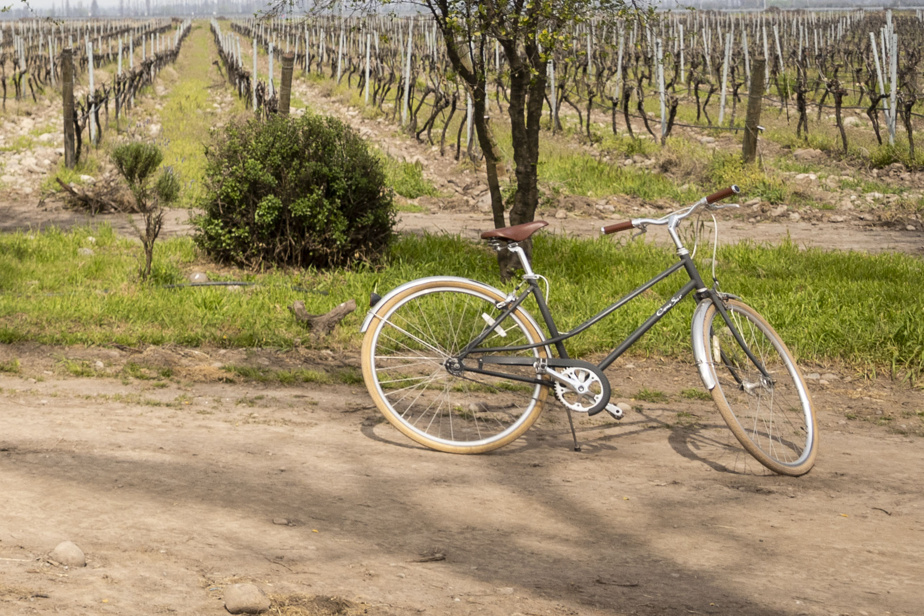(Chimbarongo, Chile) The bicycles progress gently in the stony paths, between the sections of vines, stopping here and there for a few explanations.
The bike is more than just an emblem displayed on the bottles of the range bicycle of the Chilean house Cono Sur. This vineyard offers guided tours on two wheels, a historic nod to when workers used it to get to the field.
It is also an ecological affirmation for the company, which makes environmentally sustainable production its “main pillar” and which is the second largest organic wine producer in Chile.

PHOTO SARAH MONGEAU-BIRKETT, THE PRESS
In the domain, geese roam freely.
Visitors will therefore not be surprised to come across a horde of geese wandering freely in the estate, swallowing small insects harmful to the vines – except during the few months preceding the harvest, to prevent the precious grapes from ending up in their throats.
“They are very useful for successful ecological management”, and their excreta naturally enrich the soil, explains Soledad Meneses Pastén, winemaker who has become the company’s head of communications and wine tourism.

PHOTO SARAH MONGEAU-BIRKETT, THE PRESS
Soledad Meneses Pastén, Head of Communications and Wine Tourism of Cono Sur
Cono Sur has nine sites in Chile, totaling 1,400 hectares of vines, but it is at Chimbarongo, some 150 kilometers south of the capital Santiago, that it receives visitors.
It is “the most beautiful” of all, with its imposing residence built around 1900, and it is there that all the winemaking of the company is concentrated, says Ms.me Meneses Pasten.
The building notably houses the shop and the tasting room, where imposing wicker lampshades are suspended, a material whose production has also made Chimbarongo famous.
-

PHOTO SARAH MONGEAU-BIRKETT, THE PRESS
Pinot Noir occupies an important part of the estate.
-

PHOTO SARAH MONGEAU-BIRKETT, THE PRESS
At the Viña Cono Sur estate, in Chimbarongo, an imposing residence built in 1900
-

PHOTO SARAH MONGEAU-BIRKETT, THE PRESS
The Chimbarongo site is open to visitors.
-

PHOTO SARAH MONGEAU-BIRKETT, THE PRESS
The building houses the boutique and the tasting room.
1/4
Burgundian Pinot Noir
Pinot Noir occupies a large part of the 300 hectares of the Cono Sur estate in Chimbarongo, located at the entrance to the small town, near an abandoned station which was used, in particular, to ship the estate’s production.
“It’s our specialty,” emphasizes Soledad Meneses Pastén, who shows the site to The Press on a cool September morning, when the estate still seemed to be numb from the austral winter which was drawing to a close.
To carry out a traditional vinification as it is done in Burgundy, Cono Sur uses the expertise of the French winemaker Martin Prieur.
In addition to her 300 geese, along with a few ducks and chickens, Cono Sur has a small nursery where she grows plants that she uses to control invaders.
“We use plants, trees, flowers to create biological corridors in order to attract the good insects and ward off the undesirables”, explains Soledad Meneses Pastén, at the foot of a quillay.
This evergreen tree – which does not lose its leaves in winter – is nicknamed the soap tree, because it was used in the past to make a cleansing concoction, she says: “It made the hair very shiny! »
However, it is because it is a native tree in Chile, adapted to its environment, that the company favors it to restore a biological balance on its estate, specifies Ms.me Meneses Pasten.

PHOTO SARAH MONGEAU-BIRKETT, THE PRESS
Chile is struggling with a drought that has dragged on for 15 years.
Drought
As with other businesses and people in the country, the drought that has plagued Chile for nearly 15 years is complicating matters for Cono Sur, which is now owned by Chilean wine giant Concha y Toro.
However, the domain can count on a fitted out pond allowing to accumulate the water which descends from the Andes cordillera, in particular with the melting of the snows.
“We are able to have enough water for our needs, but we have to use it with many, many precautions”, indicates Soledad Meneses Pastén, who specifies that the irrigation system is notably powered by solar electricity. .
The estate has an installed solar capacity of 600 kilowatts, which meets part of its electricity needs, and the rest is purchased from renewable sources – not all electricity sources in Chile are -, indicates the ‘business.

PHOTO SARAH MONGEAU-BIRKETT, THE PRESS
Different Cono Sur wines are offered at the SAQ
Visits and access
Guided tours, with tasting of course, take place from Thursday to Sunday, all year round; they take place in Spanish, but it will be possible to do them in English by reservation from May – their price ranges from 20,000 to 30,000 Chilean pesos (the equivalent of 33 to 50 $ CAN).
Since the small abandoned station adjoining the estate has not seen a train for several decades, the easiest way to get there is by car.
However, it is possible to take the train or bus to the nearby town of San Fernando, then travel the rest of the way in an old, worn minibus, as the locals do, and as the did The Press — being able to communicate in Spanish is however necessary.
Many of the wines produced by Cono Sur are available at the Société des alcools du Québec (SAQ), as well as the New Brunswick Liquor Corporation (ANBL) and the Liquor Control Board of Ontario (LCBO).
This report was produced with the financial support of the Fonds québécois en journalisme international.
Learn more
-
- 450 hectares
- Area of vines in organic production of the Cono Sur house, out of a total of 1400 hectares
Source: Cono Sur
- 60 million
- Number of bottles of wine produced annually by Cono Sur
Source: Cono Sur
